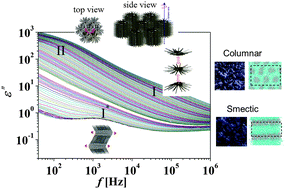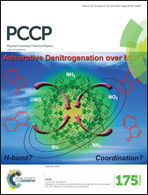Molecular dynamics of anhydrous glycolipid self-assembly in lamellar and hexagonal phases†
Abstract
The molecular dynamics of a synthetic branched chain glycolipid, 2-decyl-tetradecyl-β-D-maltoside (C14-10G2), in the dry assemblage of smectic and columnar liquid crystal phases has been studied by dielectric spectroscopy as a function of frequency and temperature during the cooling process. Strong relaxation modes were observed corresponding to the tilted smectic and columnar phases, respectively. At low frequency (∼900 Hz to 1 kHz) in the smectic phase, Process I* was observed due to the tilted sugar bilayer structure. The process continued in the columnar phase (Process I) with an abrupt dynamic change due to phase transition in the frequency range of ∼1.3 kHz to 22 kHz. An additional process (Process II) was observed in the columnar phase with a broader relaxation in the frequency range of ∼10 Hz to 1 kHz. A bias field dependence study was performed in the columnar phase and we found that the relaxation strength rapidly decreased with increased applied dc bias field. This relaxation originates from a collective motion of polar groups within the columns. The results of dielectric spectroscopy were supported by a molecular dynamics simulation study to identify the origin of the relaxation processes, which could be related to the chirality and hydrogen bonds of the sugar lipid.


 Please wait while we load your content...
Please wait while we load your content...